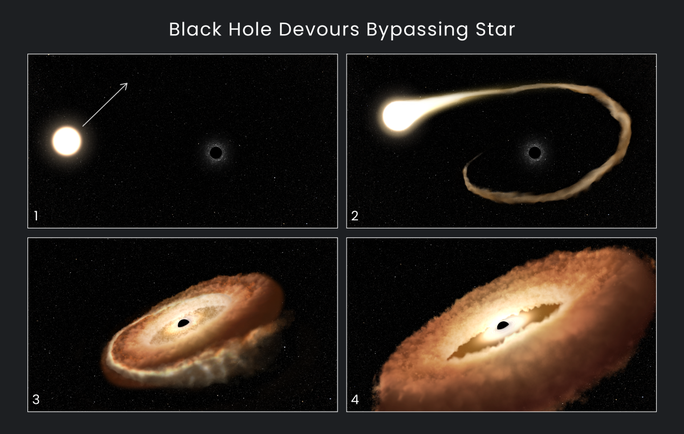An object that looks like a flying saucer or a donut floating in mid-air, as big as our solar system, has just been detected by the Hubble space telescope.
With its powerful “magic eye”, Hubble – operated by NASA in collaboration with ESA (European Space Agency) – was able to “see” a unique object at the center of the galaxy ESO 583-G004 far away. us 300 million light years.
Under ultraviolet light, the event with the code AT2022dsb appears as aUFOsor giant donut, identified as a TDE, or star-ripping black hole event.

The process of creating the “flying saucer” of the monster black hole – Photo: Hubble/NASA/ESA/CfA
Space newspaper quoted researcher Emily Engelthaler from the Harvard Center for Astrophysics-Smithsonian (CfA) as saying that observing TDEs under ultraviolet light is still very rare. It’s a treasure trove for scientists, because the ultraviolet spectrum reveals a lot of data about the object.
The TDE AT2022dsb observation team was fortunate to track its ultraviolet spectrum from the moment the ill-fated star was captured until the “flying saucer” was formed, which is the star’s matter being torn apart and transformed. into something like an accretion disk around the black hole, affected by the gravitational pull of this “monster”.
The black holes at the center of galaxies are the largest types of black holes in the universe, called supermassive or monster black holes, which often cause extremely violent events and are “omnivores”.
This black hole, like many other monster black holes, also launched a powerful “burp” into space. Scientists have recorded a stellar wind from it sweeping towards Earth at a speed of 32.2 million km/h.
The peculiar flying saucer will last for a few days to several months before the black hole completely settles its prey. The scientists claim that observing this disk of matter will help them add a lot of information to complete the picture of a TDE event.
It is estimated that this flying saucer is about the size of our solar system.
The study was just announced at the 241st meeting of the American Astronomical Society.
Source: nld.com.vn








